
Robot vacuum cleaners are more advanced and more affordable than ever. Once a novelty gadget, these household helpers are now an essential piece of kit for busy homes and pet owners, ensuring your floors stay dust and dirt-free without you having to lift a finger.
Forget those clunky old models from years ago, which would wander around aimlessly, sucking up anything and everything in their way. The latest models can map out your home and design intelligent cleaning paths and schedules. Some can automatically switch to a mopping mode when on hard surfaces, most can detect and avoid common household obstacles and pet mess, and some can even empty their own waste bins and refill their own water tanks.
While the Roomba was once synonymous with robot vacuum cleaners, today the brand faces stiff competition from the likes of Eufy, Tapo and Samsung, which, like Roomba, offer vacuums to suit every budget and every living situation.
No matter which one you choose, pretty much all of them will integrate with your smart home setup, meaning you can use Alexa, Siri or Google Assistant to set schedules or activate cleaning with a voice command, even when you’re not at home.
Even the most advanced robot vacuum cleaners we’ve tested can’t handle stairs and steps, so these helpful gadgets are best suited to flats and apartments. With that in mind, keep reading to find out which robot vacuum cleaner will reign supreme in 2025.
How we tested
We tested each robot vacuum cleaner over many months and in different homes (some with pets), paying close attention to how each robot performed in new surroundings. As well as allowing the robots to clean routinely, we subjected them to some more rigorous tests, too: spilling cornflour and rice in their path to measure their effectiveness at dealing with different types of mess.
As well as testing their hoovering skills, we rated each robot’s app and how easy they were to set up and maintain. We also considered the costs of any replacement parts – all robot vacuums wear out over time and require fresh filters, brushes, dust bags and rollers.
Why you can trust us
IndyBest is The Independent’s expert-driven shopping section. We thoroughly test every product we feature in as wide a range of conditions as possible to bring you unbiased reviews based on real-world testing. We include products to suit all budgets and only recommend products we think you’ll love.
Steve Hogarty is a technology journalist with more than a decade’s experience writing about everything from phones and laptops to the latest smart home gadgets. With help from friends and colleagues, who generously offer their floors up for testing, he’s able to measure each robovac’s true performance in different types of homes.
The best robot vacuum cleaners for 2025 are:
Eufy X10 pro omni robot vacuum cleaner
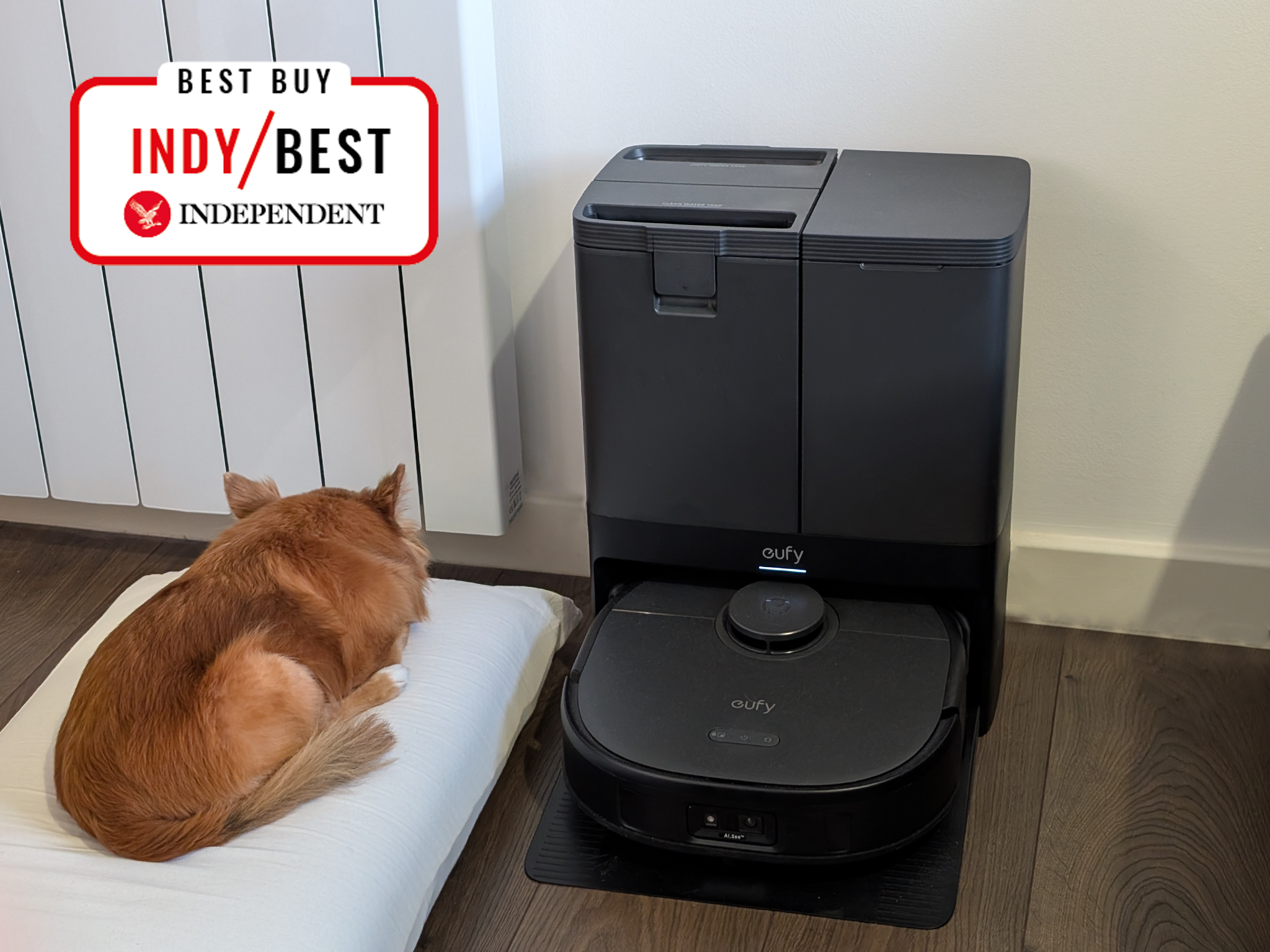
Eufy’s X10 robot vacuum is the company’s latest high-end model, and it’s the most hands-off machine we’ve tested yet. Not only does it vacuum and mop, but it’s clever enough to re-fill itself with water, as well as wash and dry its own mops. The only thing you need to do is change the water in the base station every seven days and swap out the dust bag every couple of months. Other than that, it cleans and mops for you.
The mopping function is excellent. It doesn’t just swish a mop pad around on the floor, it actually scrubs the floorboards, helping get rid of dried coffee stains. Plus, the X10 features Eufy’s best-in-class object avoidance tech, which has been trained like a self-driving car, dodging over 100 different objects, including cables, slippers and socks.
While we aren’t the biggest fan of Eufy’s app, it’s smart enough to map your home automatically, and you can customise how hard it mops, how deep it cleans and the level of suction power it exerts. It’s a really smart little vacuum that needs almost no human input to work.
Read our full Eufy X10 pro omni review
Buy now £679.00, Amazon.co.uk
iRobot roomba combo j7+
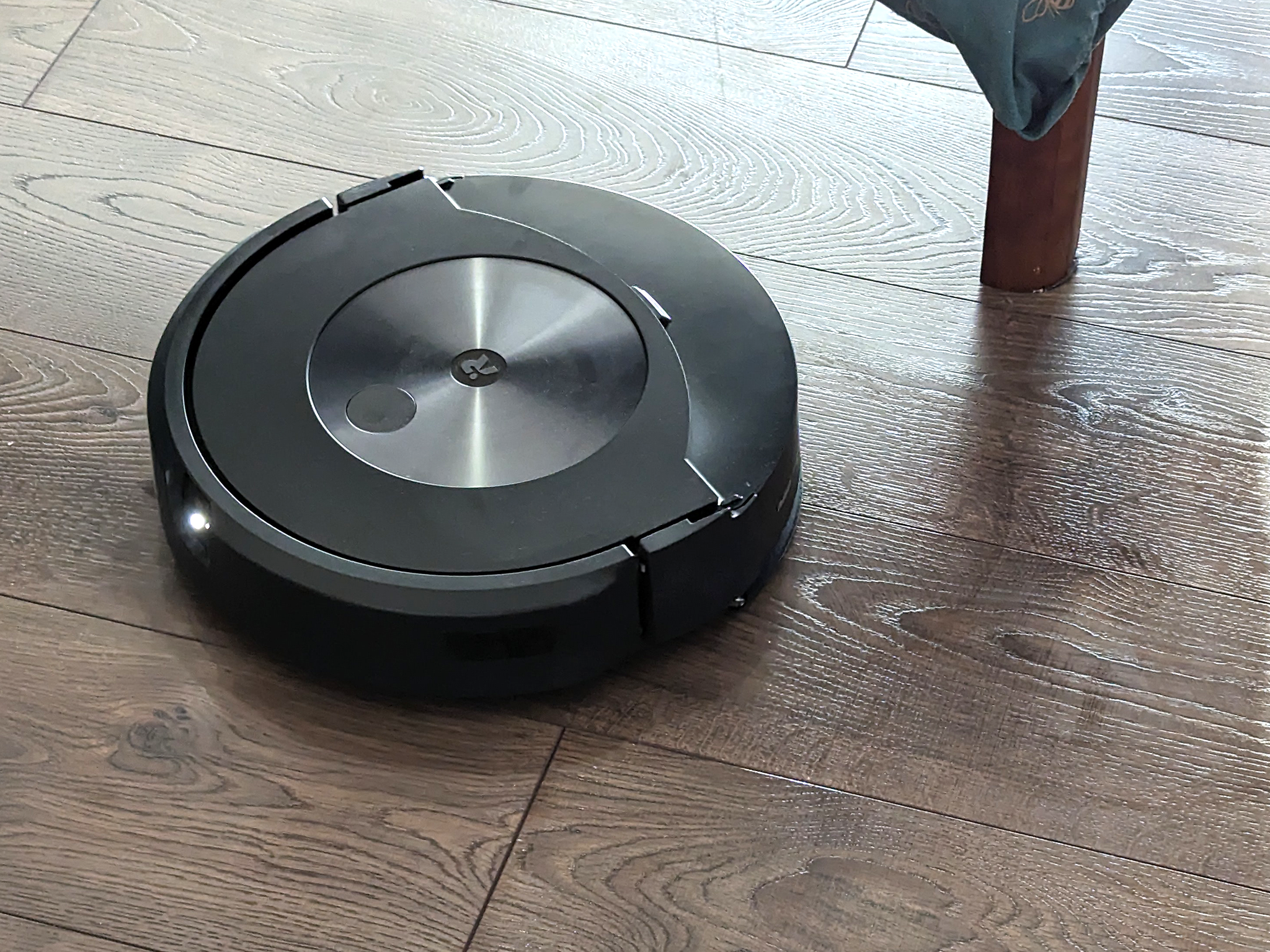
One of the best roomba iRobot makes, the combo j7 is a robot vacuum cleaner with an intelligent mopping function that switches modes automatically when it moves from hard floors to rugs and carpets.
Roomba’s best-in-class obstacle detection can spot and avoid common household hazards such as dangling cables, shoelaces, stray socks, toys and pet mess, meaning you can confidently set it going without having to “pre-tidy” – exceptionally handy in busy homes. The robot even sends you pictures of anything it’s avoided, so you can clear the space and send it around again (or, if you’re lazy, like us, dismiss the notification and promise you’ll get around to it later).
We would recommend choosing the version with the self-emptying charging base. It sounds like a jet engine when it’s emptying, but the bin holds weeks’ worth of dust and makes the robot basically fully autonomous.
The mopping tank is small, so you’ll need to refill it with detergent fairly frequently if you use it routinely. The app lets you reduce the amount of water being used, to help extend the mopping function further between refills.
Read the full iRobot roomba combo j7+ review
Buy now £379.00, Irobot.co.uk
Roborock S8 MaxV Ultra
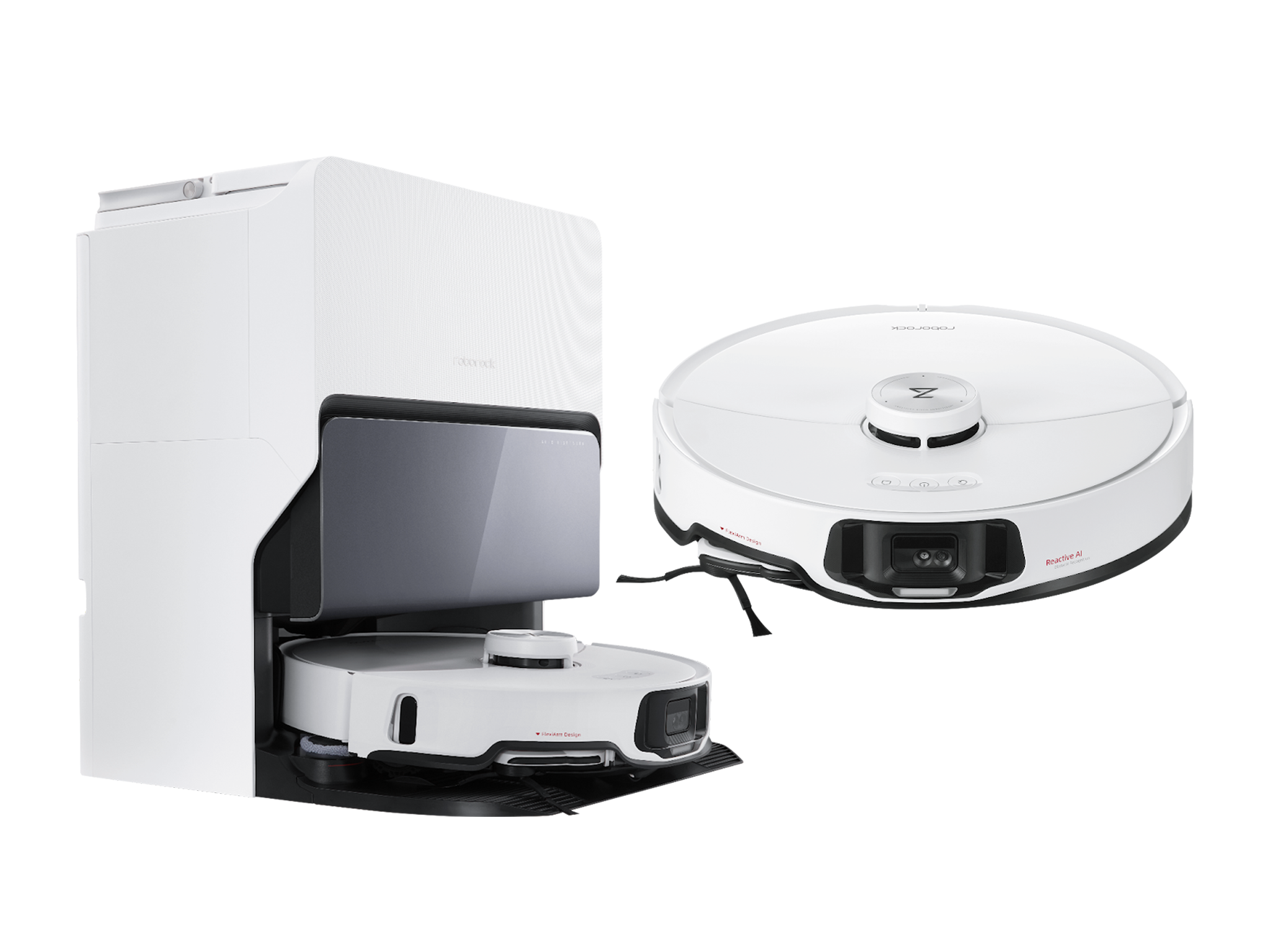
The Roborock S8 MaxV Ultra is one of the more expensive robot vacuum cleaners on the market, but it’s packed with enough premium features to justify its price. It mops and vacuums, switching modes depending on the surface. It can refill its own water tank and empty its dustbin into its base station, and it uses dual rollers, an edge brush, accurate mapping and powerful suction to deliver impressive all-around cleaning performance.
While an effective helper around the home, the Roborock S8 MaxV Ultra’s docking space is larger than expected, measuring around 45cm on every side to house its dual dust and water buckets. The base station isn’t that pretty either, so you’ll need to hide it away. The setup is straightforward though, using a slick app which is easily accessed by a QR code.
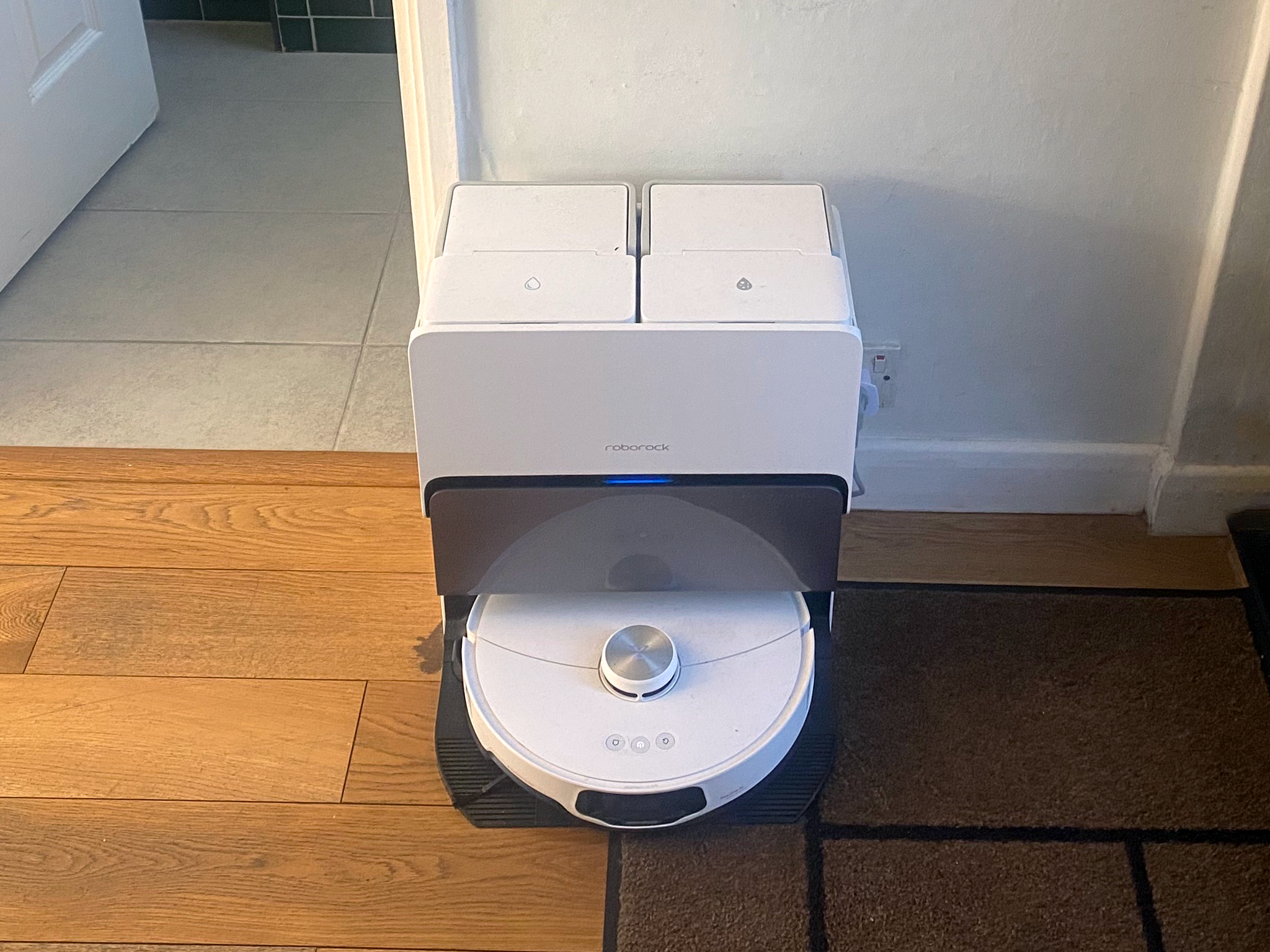
Cleaning commands can be customized for different rooms, letting you designate your kitchen, lounge, hall and downstairs bathroom separately, for example. Voice commands can then send the robot vacuum to wherever it’s needed. The S8 MaxV Ultra’s obstacle-recognition system generally does a good job at avoiding obstacles like chairs and shoes, but it occasionally needs a little intervention.
A multi-map function means it can clean different floors - unlike most robot vacuums on the market. Obviously, the robovac needs to be carried up the stairs, but this is a big improvement on other robot vacuums, which are usually limited to a single floor.
Mapping is fast and accurate, and we were impressed that the floorplans will automatically update whenever doors are left open and the robovac “discovers” a new part of the house it hadn’t seen before.
The mopping mode uses a pad rather than rotating brush heads, so results are more of a light wipe-down than a proper scrub. The S8 MaxV Ultra’s 10,000Pa suction power ensures deep cleaning, even reaching tight corners, though this comes with the downside of being rather noisy. Thankfully, it’s easy to schedule the robovac to mop and clean while you’re out of the house.
The £1,000 price tag is steep, but the convenience and saved cleaning time offered by the S8 Max V Ultra justify the investment.
Buy now £1299.99, Amazon
Tapo RV30 plus robot vacuum cleaner
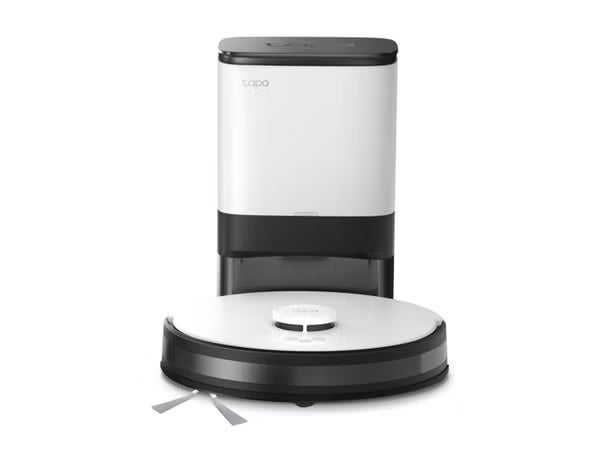
This mopping, self-emptying robot vacuum comes from networking giant TP-Link – probably best known for its internet routers rather than its home appliances. The Tapo RV30 plus has the clean and fussless appearance of a wifi hub, but the performance and features of a top-end robot vacuum.
Lidar navigation powers some competent obstacle avoidance. During our tests, the RV30 could navigate without bumping mindlessly into furniture, building a detailed map of your floorplan as it goes, to help it clean more efficiently on future runs.
The mopping function is basic enough. You need to manually swap in the attachment any time you want to mop, and it will happily try to mop your carpets and rugs given half the chance. That said, the app lets you easily designate rooms, so assigning the vacuum to mop just the kitchen or the bathroom is straightforward.
The app also adds convenient features not seen in other robot vacuums in our list. You can tell it to only use the self-emptying bin during certain hours of the day (self-emptying is loud), and you can disable the physical button on the vacuum itself, so mischievous kids and dextrous pets can’t set it going.
The Tapo RV30 is also quieter than most, particularly when on the weakest setting. Noise isn’t a concern if you set your vacuum to do its thing while you’re out of the house, but a less cacophonous vacuum should benefit those who spend more time at home.
Buy now £249.99, Tapo.com
Samsung jet bot AI robot vacuum cleaner
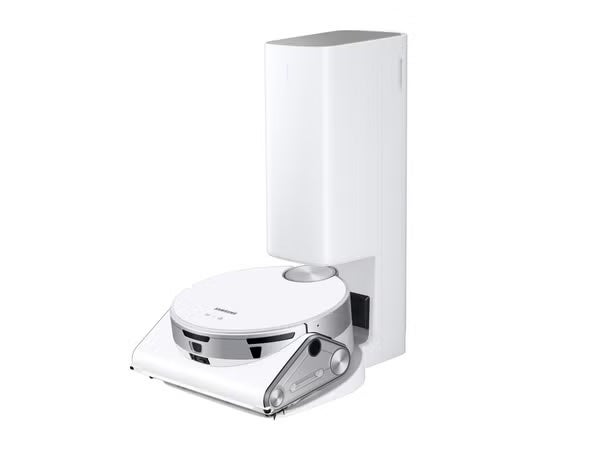
We were intrigued to see how the Samsung robot vacuum would fare, because it’s designed slightly differently from all the other models. It’s chunkier, for a start, and has a flat front and no spinning brushes at the side. It also has the most powerful suction of any robot vacuum we tried, which did mean it picked up plenty of dirt and debris around the home.
After it has finished its cleaning cycle, the jet bot returns to the clean station dock, which then sucks the dirt out of the robot and stores it in a tower. You’ll need some dedicated space for this tower because it does take up a fair amount of room. But this means you have to empty it a lot less often, and it traps dust particles in the system rather than releasing them back into the air – great for allergy sufferers.
The gadget is controlled via the Samsung SmartThings app, and, once set up, our vacuum got to work scanning and mapping the house with a good degree of accuracy. The object-recognition function meant it successfully avoided toys, piles of laundry and whatever else was left out on the floor. It mounted thick rugs with ease, too.
You can also use the app to access the camera on the vacuum and see where it is in real-time – handy if it has got stuck or you want to check up on your pet (you can guide it remotely, too). We were impressed with how clear this image was.
The jet bot senses what kind of surface it is cleaning and adapts its suction accordingly. It did a brilliant job both with hardwood and carpeted floors, getting all but a few scraps.
Buy now £257.99, Amazon.co.uk
Dyson 360 vis nav
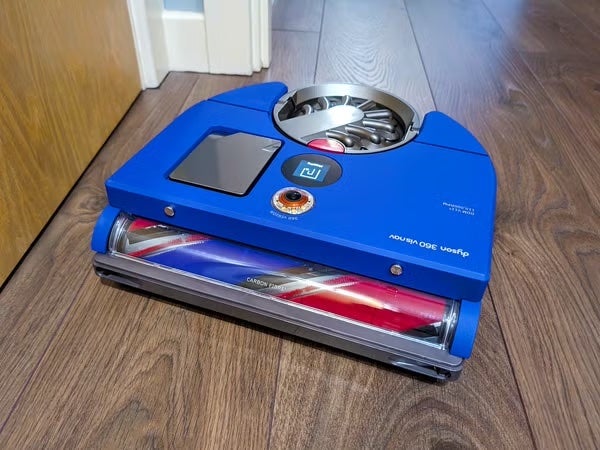
Whereas most robot vacuum cleaners start out with a robot body before adding a vacuum, Dyson seems to do things the other way around. It’s effectively a properly powerful, full-size Dyson, shrunk down to the size of a robot.
That means you get superior suction and cleaning, thanks to those chunky, full-width roller brushes, and that signature “cyclone” dust bin design. It comes in a shocking shade of blue you’ll either love or hate – we think it looks great, especially the sci-fi, 360-degree “eye” that sits atop the robot body.
This isn’t Dyson’s first robot vacuum cleaner but, because the brand is a relative newcomer to the scene, it lags behind the competition with a higher price tag, fewer features and less adept navigation skills.
There’s no mopping attachment, no cable avoidance and no self-emptying bin – all things the cheaper iRobot roomba combo j7+ offers – but it does have a few unique advantages. It can extend a little edge cleaner to tidy along skirting boards. The maximum-power boost mode lasts a paltry 12 minutes before needing to recharge, but it is practical enough to use if you’re away from home for most of the day. Dyson claims the 360 viz nav is six times more powerful than any other robot vacuum, and the results from our home tests seem to back that up.
If you absolutely must have a full set of Dyson gear for your home or really need that extra suction power, the Dyson 360 vis nav is a competent enough robovac. For those who aren’t brand loyal, however, we’d recommend opting for a more purse-friendly hoover in this list.
Buy now £1199.99, Currys.co.uk
The verdict: Robot vacuum cleaners
For homes with both carpets and hard flooring, we recommend the Eufy X10 pro omni robot vacuum cleaner. It’s remarkably good value for a self-emptying and self-refilling model, and its mopping action applies pressure to a pair of rotating brush heads to actually scrub the floor, rather than dragging a wet pad across it. The results are fantastic.
Make even lighter work of your spring cleaning, with these cordless vacuum cleaners







